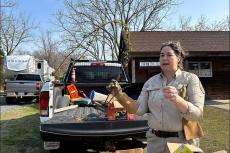The federal Environmental Protection Agency proposed on Friday the designation of two widely used perfluoroalkyl and polyfluoroalkyl substances, known as PFAS, as hazardous substances under the Comprehensive Environmental Response, Compensation, and Liability Act, also known as CERCLA or Superfund.
Designation of the substances, known as “forever chemicals,” would increase transparency around their release and “help to hold polluters accountable for cleaning up their contamination,” according to the agency.
The Suffolk County Health Department announced the discovery, in residential wells in Wainscott, of perfluorooctane sulfonate, or PFOS, and perfluorooctanoic acid, or PFOA, in levels exceeding what the E.P.A. considers acceptable for lifetime exposure. Use of the chemicals has been phased out, but they are found in numerous products, including nonstick cookware, carpets, and water, heat, and stain-resistant products.
The storage and use of Aqueous Film Forming Foam, a fire suppressant used to extinguish fuel fires, at East Hampton Airport is believed to be the source of the chemicals in Wainscott. A 2018 Health Department survey found 118 wells south of the airport to have been contaminated by the chemicals.
Discovery of the contamination led to East Hampton Town and the Suffolk County Water Authority jointly installing more than eight miles of water mains in Wainscott to connect residents whose wells were found to be contaminated to public water. It also led to a 2018 lawsuit against the town and several chemical manufacturers on behalf of a Wainscott resident.
Forty-seven acres of the airport site are on the New York State Department of Environmental Conservation’s Registry of Inactive Hazardous Waste Disposal Sites, also known as Superfund sites, based on detections of the chemicals.
The E.P.A. proposal announced on Friday is based on “significant evidence that PFOA and PFOS may present a substantial danger to human health or welfare or the environment,” according to the agency’s statement. The chemicals “can accumulate and persist in the human body for long periods of time and evidence from laboratory animal and human epidemiology studies indicates that exposure to PFOA and/or PFOS may lead to cancer, reproductive, developmental, cardiovascular, liver, and immunological effects.”
The E.P.A.’s announcement “means that these chemicals are even more serious than originally thought,” Adrienne Esposito, executive director of Citizens Campaign for the Environment, told The Star, “and it means that, really, no exposure level can be considered safe. Everything needs to be done to filter it out of drinking water supplies.”
The announcement, Ms. Esposito added, “sends a message to those with private wells that, unfortunately, that is a very risky scenario these days. Private well owners must be judicious about having their wells tested.”
If finalized, the proposal would trigger reporting of PFOA and PFOS releases, improving the E.P.A.’s understanding of the extent and locations of contamination, and providing an option to require cleanups and recover cleanup costs, according to the announcement.
Designation of PFOA and PFOS as hazardous substances under the Comprehensive Environmental Response, Compensation, and Liability Act would also require the reporting of releases exceeding the reportable quantity — 10 parts per trillion in the state — to the National Response Center, state or tribal emergency response commissions, and local or tribal emergency planning committees. “A release of these or any other hazardous substance will not always lead to the need to clean up or add a site to the National Priorities List, liability, or an enforcement action,” according to the E.P.A. The reporting of a release, the announcement said, “could potentially accelerate privately financed cleanups and mitigate potential adverse impacts to human health and the environment.”
Designation of the chemicals could also allow the E.P.A. to seek recovery of cleanup costs from polluters or require them to conduct the cleanup.
The E.P.A. will publish its Notice of Proposed Rulemaking in the Federal Register, upon which a 60-day comment period will begin.



